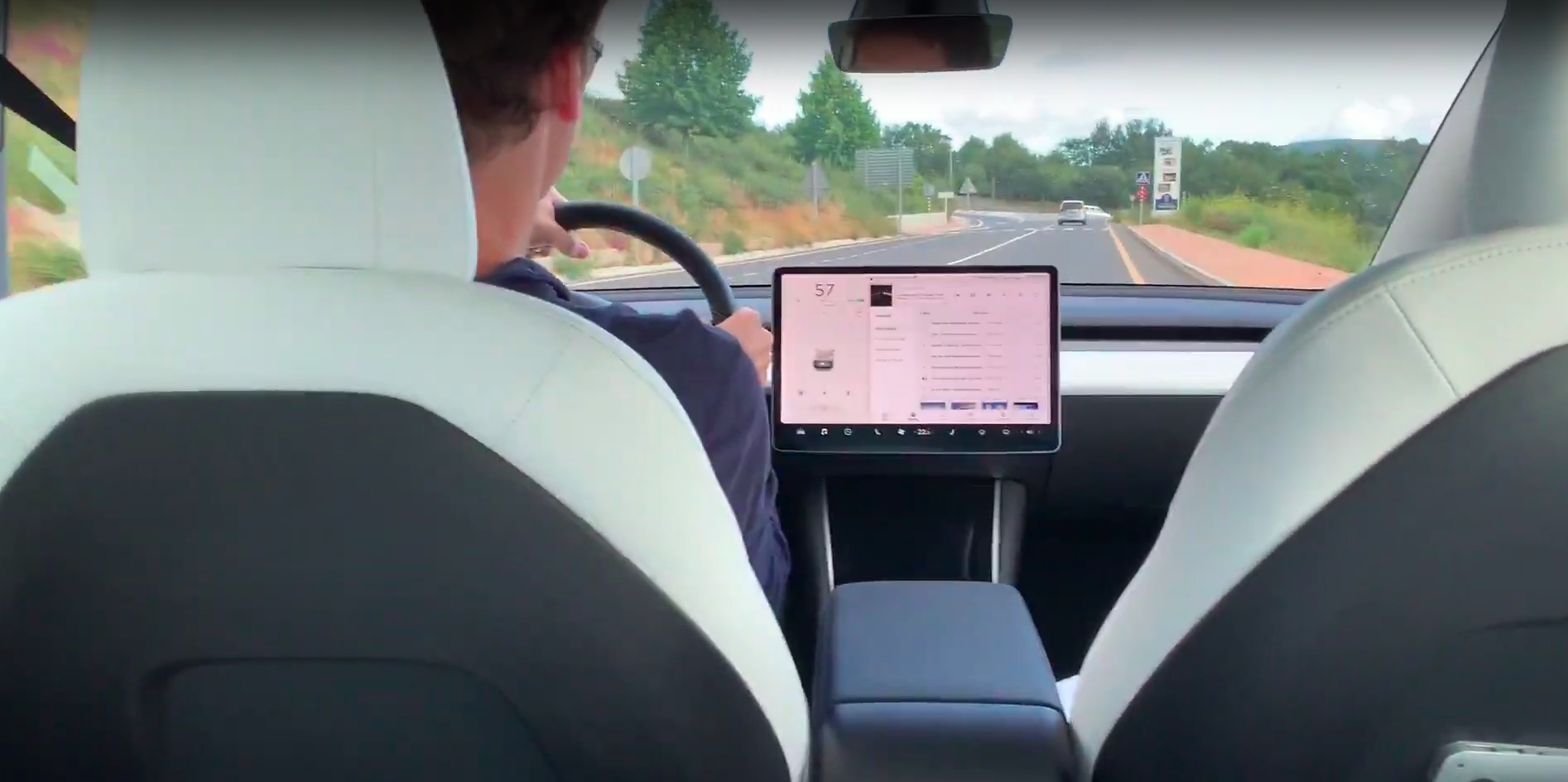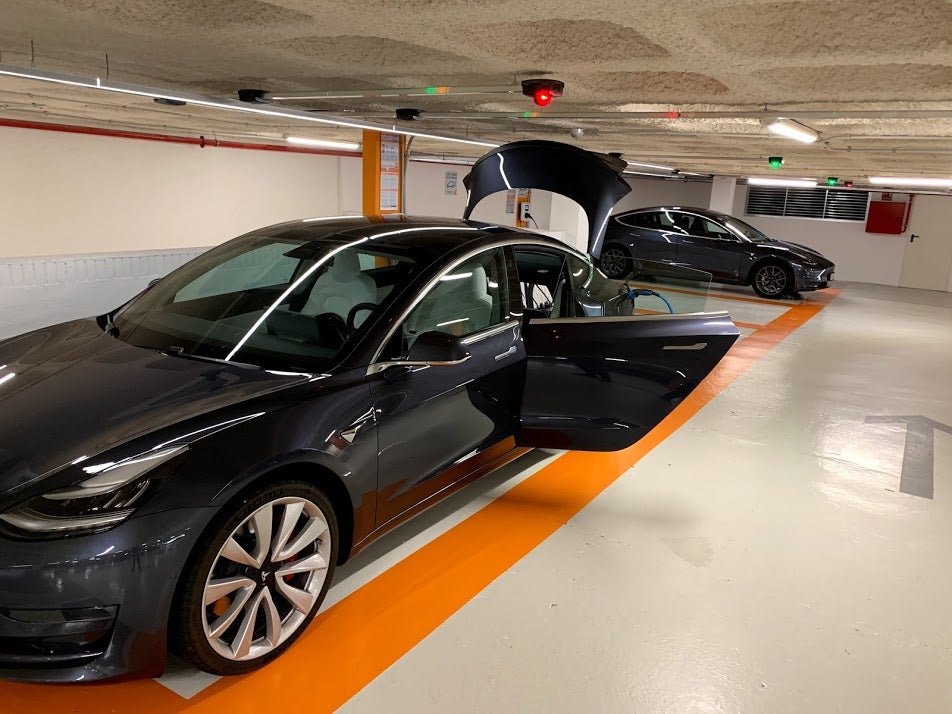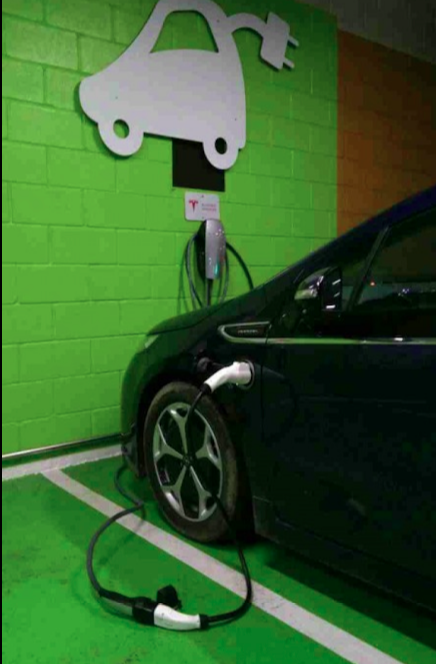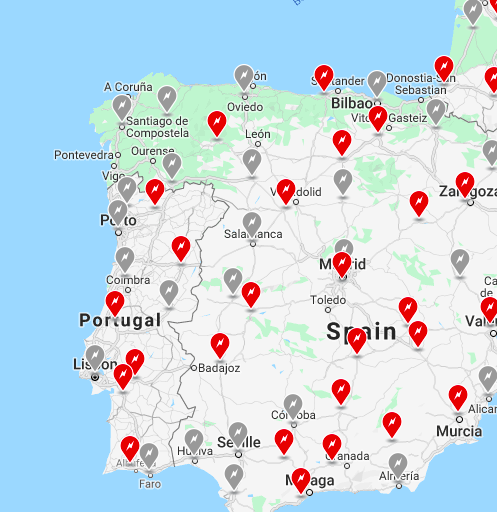 "Spanfeller is a twat" (theaspiringengineer)
"Spanfeller is a twat" (theaspiringengineer)
10/27/2019 at 09:12 ē Filed to: None
 4
4
 1
1
 "Spanfeller is a twat" (theaspiringengineer)
"Spanfeller is a twat" (theaspiringengineer)
10/27/2019 at 09:12 ē Filed to: None |  4 4
|  1 1 |

Pictured: the only driving shot I have of the Model 3 in the Google Photos cloud.
Ever since I got to test my grandfatherís Model 3, I wanted to talk about the actual process of getting it to him, which was the first road trip we used the car for and, coincidentally, the only road trip that has been longer than the carís practical range.

Immediately after receiving the car in Madrid, I had to take it out of its urban comfort-zone and into the Galician countryside: a 574 km journey just outside of the Model 3s range. Not to fear, for Tesla had a supercharger a couple of hours north of Madrid and I was eager to test the Autopilot feature. Unfortunately, the car was delivered with a buggy version of the operating system. Usually autopilot takes 20 minutes to calibrate, but I was stuck at 4% calibration for the entire journey. Even the cruise control remained disabled.
The first two hours were very enjoyable, as I was virtually unchecked; the car could go 130km/h the whole time, I could scare M4s in the highway, I could go on the fast lane and worry very little about how much charge I had. The first supercharger was just two hours away!
The supercharger network in Europe uses two types of port: the Mennekes port found in the Model S and Model X, and the CCS2 DC combo found in the Model 3. These ports are the standard ports for European EVs. The Supercharger was desolate, and the hotel next to it was unwelcoming, so instead of going inside I tried to figure out how to solve the first issue the Tesla had. I had the car do a hard reset... which I thought would be sufficient for the computer to get its head straight.

A Better Route Planner tends to be less optimistic than the Tesla navigation app.
I didnít take a picture of the Supercharger, but it did feel slow to charge. Teslaís route planner recommended that I charge to 90% and I charged to 95% from around 40%. This would be the hardest part of the journey, because even if I was around 1/3rd of the way there, the rest would be uphill.
Range anxiety kicked in, on the very first day of use and with a supercharger connected to my car: it is nerve wracking. Since I couldnít use cruise control, I would sometimes slip out of the recommended cruise speed that the computer suggested. I know that the time difference between doing the speed limit and going 10 under, even in such a long journey, is minimal, but you feel it.

The first, and thus far only, time George Michael was charged using the CCS2 DC Combo at the Tordesillas Supercharger.
It makes you feel inadequate next to ICE vehicles that can stop for fuel every 20 km if they wanted to... they could practically do the journey on a punctured tank.
The sole puncture on my battery however, was the intermittent use of the air conditioning as the sun blasted in through the glass roof and heated the cabin. At a steady 100km/h on the slow lane, I started to notice some bratty kids in a Swiss-registered CLS class that would overtake me, and then stop, and overtook me, and then stopped. This happened multiple times, eventually I had to stop as well, because the drive was too mentally taxing.
I knew that the best way to drive would be doing 105 km/h in the flat, slowing down to 85 during uphill sections, and not going above 110 during downhills to let the regen do itís magic. But as a novice of one-pedal driving; I wound up being too heavy footed for regen to work in some of the hills, finding the correct balance was harder than it would be in an ICE car.
It was then that I figured out how to solve my problem: Parental Controls. You see, even if my cruise control was disabled because a tangentially related system was not working, I could ask the car to stop giving me power past 115km/h. Brilliant. but then anytime I went near a downhill this would appear on my phone:

George Michael Bluth was a great highway cruiser when it had the energy to do it.
Eventually, I had racked up 150 notifications from the Tesla app, letting me know that I was being a bad driver. Even though it provides a similar function to a cruise control, the parental limitations can only be changed when the car is stationary, so it was very inconvenient no matter how much battery it saved me.
Even with my battery saving methods, the car went under 20% battery by the time I arrived at the outskirts of Ourense City, which is where I gave up. Rather than trying to continue up what had become my seven hour long sisyphean journey, I stopped for coffee and battery.
Despite being the Provincial capital, Ourense had three public charger ports. Three! Goddamn. ports. The one at the carrefour was closed in May to my surprise. Which is fine when you stop and actually think. ďWho else has one of these stupid things over here?Ē
Then you realize that because it isnít Madrid, finding a level 2 charger is harder than finding an AtletŪ supporter, and so you desperately offload onto your phone an array of apps that might just be able to assist you in finding the few that do exist.

Not pictured: Joan XXIII charger in Ourense
My destination was then Joan XXIII parking lot near the city center. It wasnít a fast charger by any means, but it let me get out of the car for the first time since Castille. The only thing I could think of was that I had done this journey two years ago in an internal combustion car and I didnít face any of the issues; the gas pumps werenít slow, I didnít have to stop 40 minutes away from home because of an empty fuel tank... and I certainly completed the journey in around six hours.
Then you need to consider how fucking expensive the whole thing is; A charger in Santiago de Compostela operated by Nissanís ďEasy ChargerĒ cost 54 cents per kWh.... thatís more than triple what domestic rates are! The charger at Joan XXIII had a three euro flat rate, given its power output of 7kWh, it would actually mean that they start losing money on the charger after around 2:40 hours of charging...thatís about 20kWh, which is half of the capacity of regular EVs like the Leaf, and less than a third of the Teslaís capacity.
In Vigoís mall however, the charger is free, and so is the parking! But this charger is marked as a Tesla Destination charger, because other EVs use the Mennekes plug, then other non-tesla EVs park and charge there. Which is funny in the strangest way.

Another funny thing in Europe is that most stations donít actually have a cable, you need to bring your own, and connect it into a socket, which is different to the American style stations Iíve seen.
So itís clear that the private sector is still ages away from understanding how EV charging stations will work.
After an ice cream and some coffee. I left Ourense with around 35% charge, and got home with 22%. nine hours after departing from that warehouse in Madrid. I know I couldíve continued on, and gotten home on like 7%, but in the end... this wasnít my car, and if it was, Iíd be annoyed about getting a new toy and not being able to try it out the moment it got to my house. Specially considering that we were yet to install the 7kWh charger at home, and the car would have to charge at a painfully slow 1kWh for the next few days.
!!! UNKNOWN HEADER TYPE (MULTI-LINE BREAK?) !!!

The ICE car racked up a huge bill, even an efficient diesel car would cost around 40-80 euros, but it would take around five and a half hours if it didnít stop. The Tesla however, cost 17 euros to move, and it took nine hours. I know that the journe couldíve been significantly shorter if I had cruise control, actually charged to 99% and better supermiling abilities.
Thankfully, Tesla is in the process of installing a couple of superchargers for its north-western customer base which will make the journey shorter, cheaper, and more comfortable.
I came out of it conscious of the limitations EVs have, but also very respectful of their capacity, I did nearly 600 km on the energetic equivalent of 8-10l of gasoline.
It also taught me more about physics than what I could ever learn at a classroom; wind resistance is bad, man. The only reason ICE cars get better fuel economy on the highway than they do in the city is because the fuel economy in the city is already miserable to begin with. It really isnít a fair comparison, if a Model 3 were to have the capacity to store the equivalent of 60l of gasoline like a regular car, it would have a range of 4,100km!
With that in mind, all the stress and the fatigue, Iím reminded of the supercharger I did have to stop in; the experience is not great. The Hotel didnít have any services I wanted... Perhaps I arrived a bit shell shocked by the Teslaís early fault (which was fixed overnight once it had some Wifi) and I didnít look around for a coffee or a snack machine, but they really need to improve the amenities at the rest stops... The Repsol nearby felt like a palace compared to the lonely supercharger. In fact, they need to improve customer relations in general since itís not such a glamorous experience as it is in the United States.
The apps were also quite impressive, and it made me think about other EV owners in Galicia who mapped the shit out of the province looking for chargers absolutely everywhere prior to us getting into the action. Even if they drove Zoes and Amperas, and probably despised gear-heads, they were proper auto enthusiasts, and their work for the community is priceless.
Even with all the bad, Iím in such awe of the Teslaís capabilities, that I canít stop thinking about the next road trip Iíd like to take on it:

 pip bip - choose Corrour
> Spanfeller is a twat
pip bip - choose Corrour
> Spanfeller is a twat
10/27/2019 at 02:25 |
|
do the Ďring